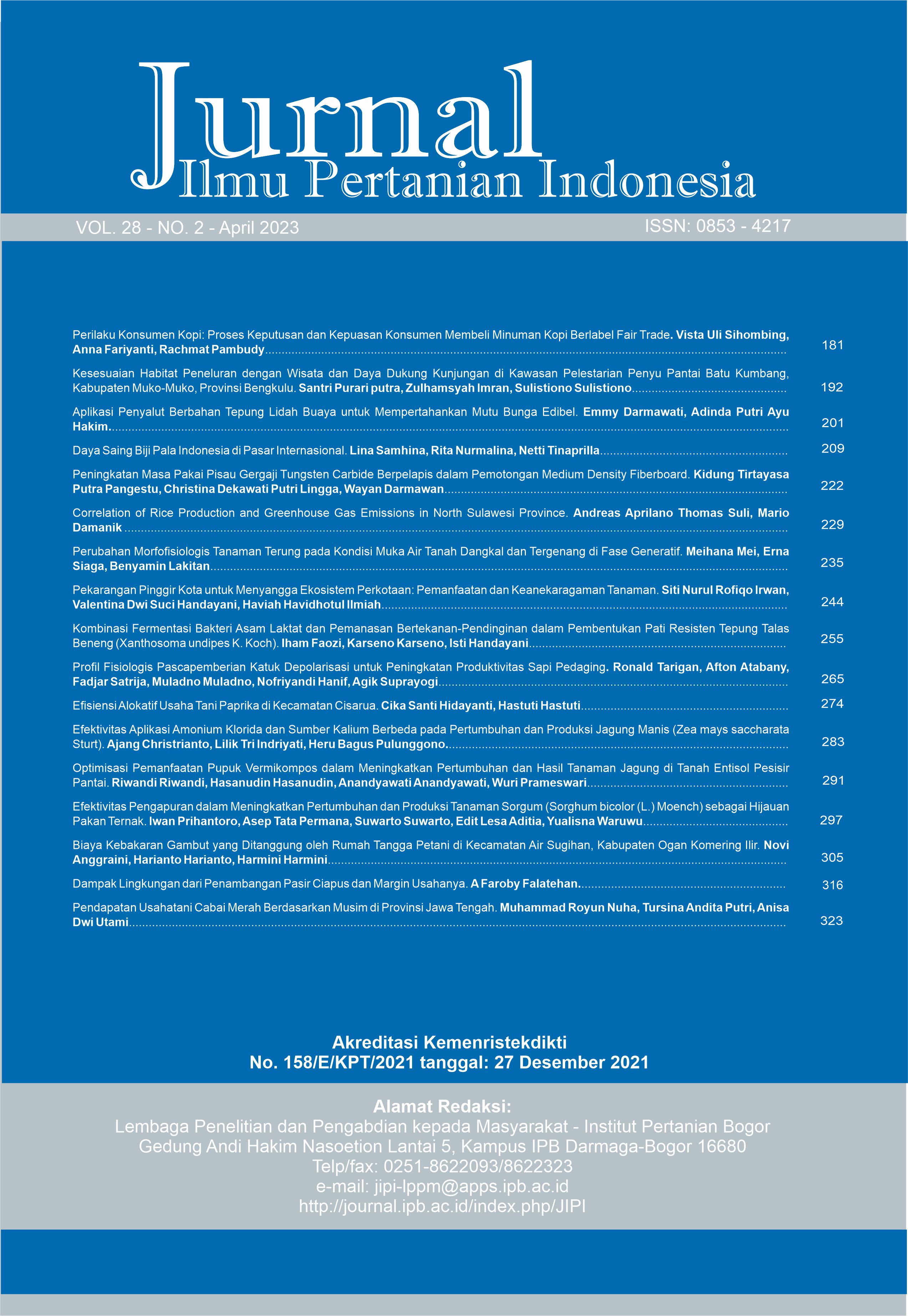Daya Saing Biji Pala Indonesia di Pasar Internasional
Abstract
Indonesia is a nutmeg exporter with the highest export value during 2012‒2020. However, the growth of Indonesia's export value is lower than its competitors. Therefore, to maintain its position as a major exporter, it is important to know its competitiveness. This study aims to explain the competitiveness of Indonesian nutmeg in the world and in ten export destinations. In addition, this study was conducted to analyze the competitive position in the export destination market. The study uses secondary data from UN Comtrade. The data are Indonesian export values of whole and powdered nutmeg in the international market and in ten destination countries during 2012‒2020. The data were processed using revealed comparative advantage (RCA) and dynamic revealed comparative advantage (DRCA) analysis. The results showed that Indonesian whole and powdered nutmeg were competitive in the world market. However, the competitiveness is lower than nutmeg competitiveness of Sri Lanka. Indonesian nutmegs in ten destination markets are also competitive, with the highest competitiveness being in Italy and Germany. Nevertheless, the always positive growth of competitiveness from two products occurred in Japan, thus make Japan's competitive position in rising star during the period of 2018‒2020. Increasing the competitiveness of nutmeg can be done by increasing the export value of the product through regulations by the government regarding post-harvest handling so that there is only a small amount of aflatoxin. In addition, the government can more focus on increasing exports to Japan.
Keywords: competitiveness, dynamic revealed comparative advantage, revealed comparative advantage, nutmeg
Downloads
References
Anggrasari HP, Perdana P, Mulyo JH. 2021. Keunggulan komparatif dan kompetitif rempah-rempah Indonesia di pasar internasional. Jurnal Agrica. 14(1): 9‒19. https://doi.org/10.31289/agrica.v14i1.4396
Asrol dan Heriyanto. 2017. Daya saing ekspor pala Indonesia di pasar internasional. Jurnal Dinamika Pertanian. XXXIII(2): 178‒188.
Atase Pertanian Kedutaan Besar Republik Indonesia di Brussel. 2020. Paper analisa potensi ekspor komoditas perkebunan Indonesia di Uni Eropa.
Benedictis L, Tamberi M. 2002. A note on the Balassa index of revealed comparative advantage. JEL Classification. C10, F14. https://doi.org/10.2139/ ssrn.289602
Edwards L, Schoer V. 2002. Measures of competitiveness: A dynamics approach to South Africa’s trade performance in the 1990s. The South African Journal of Economic. 23(2): 159‒179. https://doi.org/10.1111/j.1813-6982.2002.tb00055. x
Food Agriculture Organization. 2022. [Internet]. [diunduh 2022 Jan 15]. Tersedia pada: http://www. fao.org/faostat/en/#compare.
Hasibuan AM. 2012. Analisis kinerja dan daya saing perdagangan biji kakao dan produk kakao olahan Indonesia di pasar internasional. Buletin RISTRI. 3(1): 57‒70.
Hinloopen J. 2001. On the empirical distribution of the Balassa index. Review of World Economics. 137(1): 1‒49. https://doi.org/10.1007/BF02707598
Jannah EM, Nurmalina R, Asmarantaka RW. 2019. Tingkat persaingan eksportir utama lada dunia. Jurnal Agro Industri Perkebunan. 7(2): 107‒120. https:// doi.org/10.25181/jaip.v7i2.1128
Kurnianto DT, Suharyono, Mawardi K. 2016. Daya saing komoditas lada Indonesia di pasar internasional (Studi tentang ekspor lada Indonesia tahun 2010‒2014). Jurnal Administrasi Bisnis. 40(2): 655‒666.
Kurniawati AM, Yulianto E, Abdillah Y. 2016. Pengaruh harga tembakau internasional, jumlah produksi domestik dan nilai tukar terhadap nilai ekspor tembakau Indonesia (Studi ekspor tembakau Indonesia tahun 1985‒2014). Jurnal Adminstrasi Bisnis. 38(2): 23‒31.
Mashari S, Nurmalina R, Suharno. 2019. Dinamika daya saing ekspor udang beku dan olahan Indonesia di pasar internasional. Jurnal Agribisnis Indonesia. 7(1): 37‒52. https://doi.org/10.29244/jai.2019.7.1.37-52
Ningsih EA, Kurniawan W. 2019. Daya saing dinamis produk pertanian Indonesia di ASEAN. JEKT. 9(2): 117‒125.
Novidayanti V, Hodijah S, Mustika C. 2019. Faktor-faktor yang memengaruhi ekspor pala Indonesia ke Vietnam. E-Journal Perdagangan Industri dan Moneter. 7(2): 61‒72. https://doi.org/10.22437/ pim.v7i2.8668
Nurhayati E, Hartoyo S, Mulatsih S. 2019. Analisis pengembangan ekspor pala, lawang, dan kapulaga Indonesia. Jurnal Ekonomi dan Pembangunan Indonesia 19(2): 173‒190. https://doi.org/10.21002/ jepi.v19i2.847
Patty Z, Kastanja AY. 2013. Kajian budi daya tanaman pala di Kabupaten Halmahera Utara (Studi kasus di Kecamatan Galela Barat, Tobelo Selatan dan Kao Utara). Jurnal Agroforestri. 8(4): 294‒300.
Purba HJ, Yusufi ES, Hestina J. 2020. Performance and competitiveness of Indonesia nutmeg in export market. E3S Web of Conferences [Internet]. [diunduh pada 2020 Des 09]. Tersedia pada:. https://doi.org/10.1051/e3sconf/202123202018
Ratnasari DE, Suyanto, Sundari MS. 2020. Analisis komparasi daya saing ekspor teh Indonesia dan Vietnam serta faktor yang memengaruhi daya saing teh Indonesia. Calyptra. 8(2): 132‒151. https:// doi.org/10.21082/jtidp.v5n1.2018.p1-10
Rosiana N, Nurmalina R, Winandi R, Rifin A. 2018. Dinamika persaingan kopi robusta Indonesia dengan negara-negara pesaing utama. Jurnal Teknologi dan Industri Pangan. 5(1): 1‒10.
Sayidah A, Iskandar S, Iswarini H. 2014. Analisis faktor-faktor yang memengaruhi ekspor biji pala Indonesia. Societa. III(2): 103‒107.
Suhartini NA, Widi RH, Darusman D. 2021. Daya saing pala, lawang, dan kapulaga Indonesia di pasar internasional. Jurnal Agristan. 3(2): 84‒110. https:// doi.org/10.37058/agristan.v3i2.3685
Susanti, Yuliana. 2021. Analisis ekspor biji pala Indonesia ke tujuh negara Uni Eropa periode 2012‒2019. Seminar Nasional Official Statistic 2021. https://doi.org/10.34123/semnasoffstat.v2021i1.1019
Tambunan T. 2001. Perekonomian Indonesia: Teori dan Temuan Empiris. Jakarta (ID): Ghalia Indonesia.
Triwibowo K, Falianty TA. 2017. Analysis of the implementation of sanitary and phytosanitary (SPS) measures in the European Union (EU) on the export of Indonesian pepper and nutmeg. In: Proceedings of The Asia Pacific Research in Social And Humanities. Topics in Social and Political Sciences, Depok, Indonesia, 7–9 November 2016. https://doi.org/ 10.1201/9781315213620-33
United Nations Comodity Trade. 2022. United Nations Comodity Trade Statistics Database 2022. [Internet]. [diunduh 2022 Jan 15]. Tersedia pada:https:// comtrade.un.org/data/.
Wahidin D, Purnhagen K. 2018. Improving the level of food safety and market access in developing countries. Heliyon. 4(7): 1‒24. https://doi.org/ 10.1016/j.heliyon.2018.e00683
This journal is published under the terms of the Creative Commons Attribution-NonCommercial 4.0 International License. Authors who publish with this journal agree to the following terms: Authors retain copyright and grant the journal right of first publication with the work simultaneously licensed under a Creative Commons Attribution-NonCommercial 4.0 International License. Attribution — You must give appropriate credit, provide a link to the license, and indicate if changes were made. You may do so in any reasonable manner, but not in any way that suggests the licensor endorses you or your use. NonCommercial — You may not use the material for commercial purposes.






















